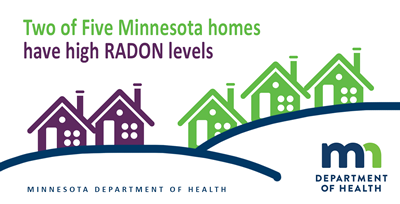Radon in Minnesota - MN Public Health Data Access portal
Radon
Radon can be found throughout Minnesota

Radon is a colorless, odorless radioactive gas that naturally comes from the soil. Radon can enter any building—homes, offices, and schools—and result in a high indoor radon level. Radon gives off radioactive particles that, when breathed in, can damage the lining of the lungs.
Radon is a serious public health issue in Minnesota, where 2 in 5 homes tested have radon levels that are a major health risk. Minnesota has high radon levels due to its unique geology and cold climate. During the winter, home heating systems tend to draw in radon gas from the soil, increasing radon levels inside the home. Many Minnesotans also use basements as living spaces, which can increase radon exposure.
Radon is the second leading cause of lung cancer
Minnesotans can order discounted radon test kits>.
Order your kit today.
Find a radon mitigator.
The U.S. Surgeon General has warned that radon is the second leading cause of lung cancer in the United States today. Only smoking causes more lung cancer deaths. If your home has high radon levels and you smoke, your risk of lung cancer is even higher. Radon accounts for about 21,000 lung cancer deaths every year. You don’t have to be a smoker to get lung cancer; 2,900 lung cancer deaths were nonsmokers.
Test your home for radon
Radon is present everywhere, but the greatest exposure is inside buildings. Radon exposure is most likely to happen at home, where people spend most of their time. Your home can have high radon levels whether it is old or new, well-sealed or drafty, and with or without a basement. All houses have some radon, but even houses next to each other can have very different radon levels. The only way to measure your radon risk is to test your home. If you do have high radon levels in your home, there are ways to reduce it.
What is being done about radon exposure?
- MDH provides information on radon and how to protect your family's health. You can also view our radon mitigation disparities interactive maps..
- The US Environmental Protection Agency provides information and resources about radon, its health effects, and its control.
- The World Health Organization has an on-going WHO International Radon Project to collect and analyze information on radon risk, radon policies, radon mitigation and prevention, and radon risk communication.
Learn more:
New report: Testing Trends for Radon in Indoor Air in Public Schools (PDF)
Case Study: Novel Data Analysis Identifies Higher Radon Risks Statewide and Informs County Officials
